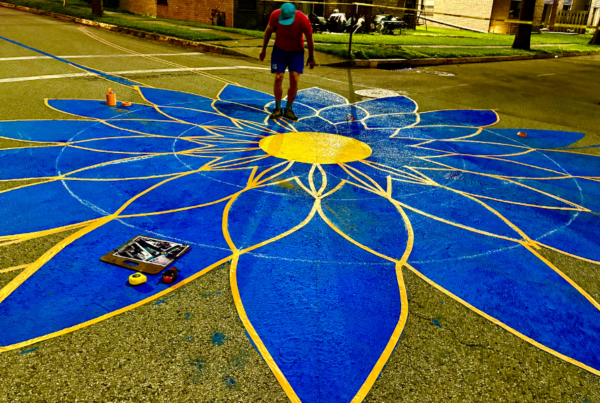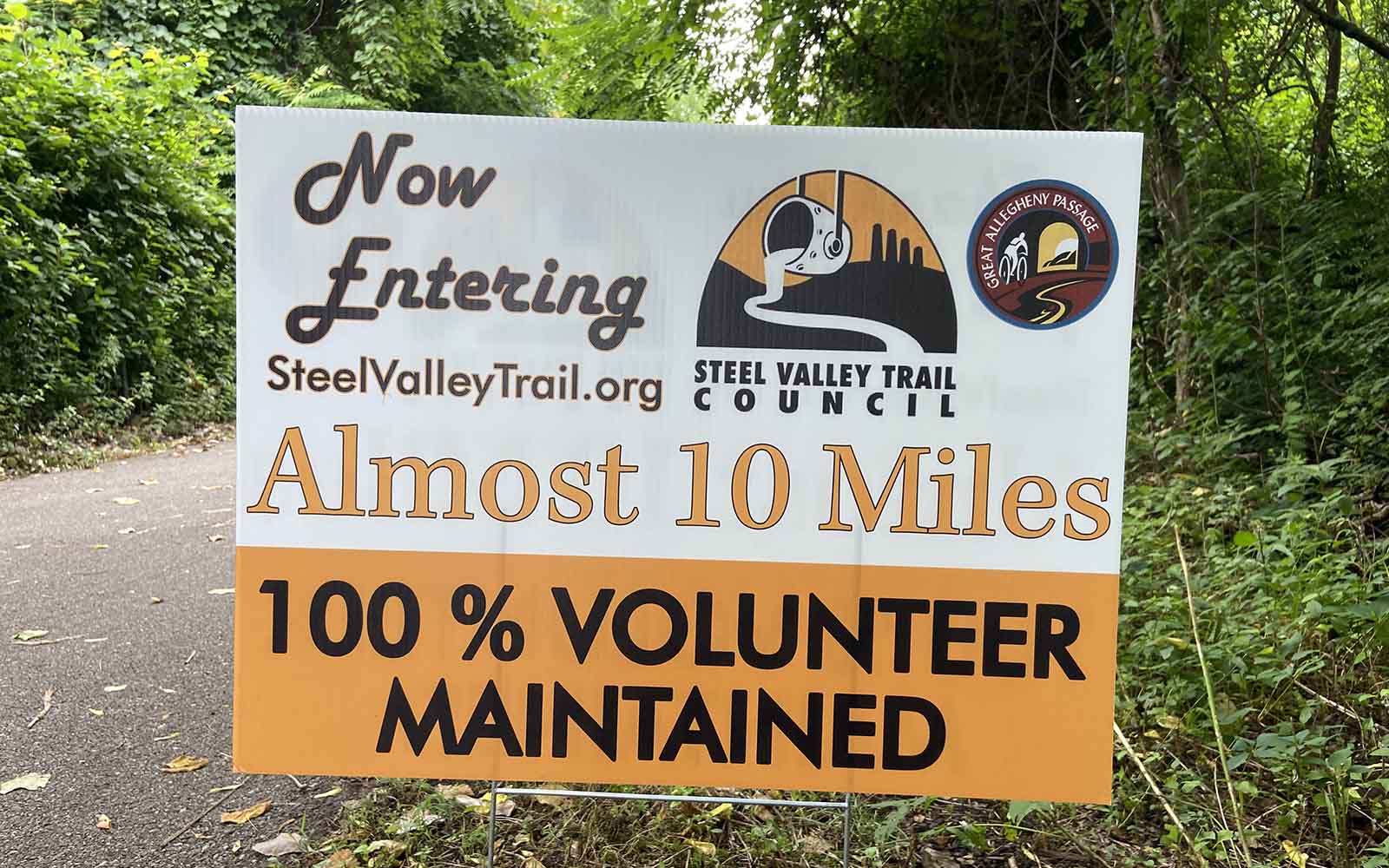
A sign greets travelers along the Steel Valley Trail.
Community Spotlight
The Community Spotlight series features the efforts Rivers of Steel’s partner organizations, along with collaborative partnerships, that reflect the diversity and vibrancy of the communities within the Rivers of Steel National Heritage Area.
By Gita Michulka, Contributing Writer
Steel Valley Trail Council Connects Riders to the Region
If you are familiar with the Great Allegheny Passage, you may know that it runs 150 continuous miles from the Point in Downtown Pittsburgh to Cumberland, Maryland, where it then links to the C&O Canal Towpath for an additional 184.5-mile trek through to Washington, D.C.
But you might not know that there is a nine-mile section of the trail that travels from Pittsburgh through seven local towns in quick succession—or that this portion of the trail is maintained by the Steel Valley Trail Council. One dedicated board member is working to change what you know about his stretch of the trail.
Roy Bires supports the efforts of the Steel Valley Trail Council, one of several volunteer-led trail chapters of the Regional Trail Corporation (RTC), which acquires, develops, manages, and maintains trail and water corridors within southwestern Pennsylvania. These organizations are each responsible for maintaining a section of the trail and helping the RTC promote opportunities for recreation, volunteerism, education, tourism, economic development, and historic and environmental conservation.
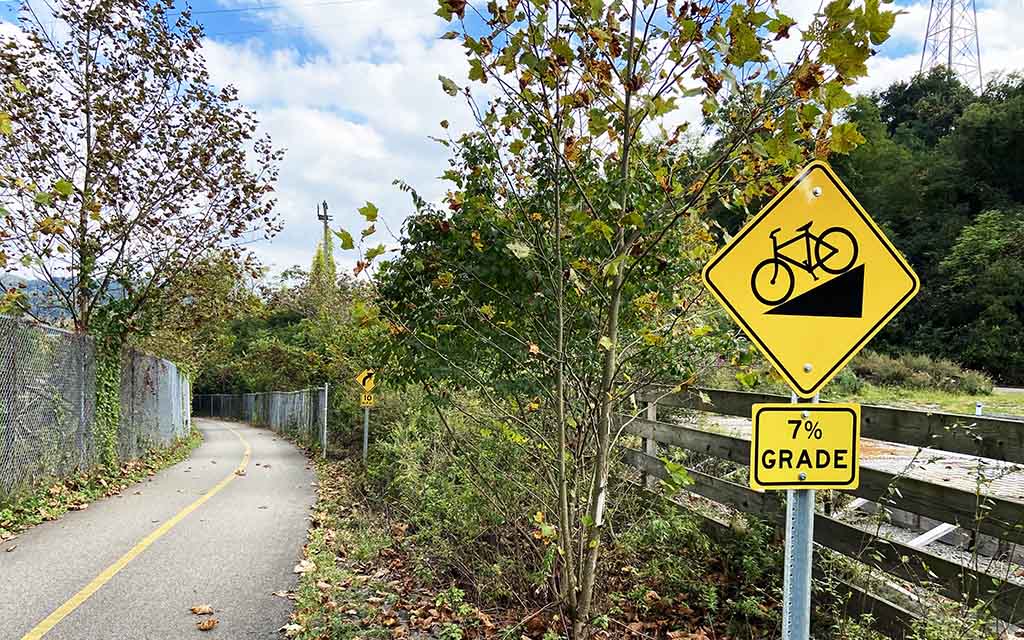
A downhill section of the trail before improvements were made. What was a blind bend now has a clear line of sight after volunteers removed a section of fence and honeysuckle bushes.
“The Great Allegheny Passage trail that runs behind the Waterfront in Homestead was built around 2000, but it wasn’t until 2011 that the trail opened up from McKeesport to the Waterfront, and two years later in 2013 the trail was completed through Sandcastle and past the Keystone Iron and Metal Co.,” notes Bires, who joined the organization just about a decade ago.
“This section of the GAP Trail, from McKeesport to Waterfront, was the next-to-last section of trail to open up between Cumberland and Pittsburgh, and so it is lacking in interpretive signs compared to other older sections of the trail,” he continues.
While working as maintenance supervisor, a role that includes volunteer coordination and weekly site visits to maintain the trail by cutting back grass and brush, trimming trees off of the path, digging out overgrown drains, repairing fences, and cleaning up rock slides, Bires is also working hard to make sure riders know that their organization exists.
With funding from Rivers of Steel’s Mini-Grant Program, Bires is collaborating with graphic designers to finalize a series of signs that amplify a rider’s experience with this historic section of trail.
“Our section of the trail only had two interpretive signs, one that was at the Lock and Dam that is behind Kennywood, and one about Kennywood itself. A couple of years ago during a ride, we were traveling through what used to be the Duquesne Steel Mill, and someone stopped me and said ‘What did this used to be?’ And I was, for a second, like—how could you not know this was the Duquesne steel mill?” Bires notes with laugher. “Then I realized, if you were born after 1980, you would have no clue.”
The Steel Valley Trail Council portion of the GAP Trail begins where the South Side Riverfront Trail ends, at the Keystone Iron property, and runs through West Homestead, Homestead, Munhall, Whitaker, Duquesne, West Mifflin, and into McKeesport. Along with the Duquesne Steel Works, other notable landmarks include the U.S. Steel Homestead Works in the Waterfront, Kennywood Park in West Mifflin, and the National Tube Works in McKeesport.
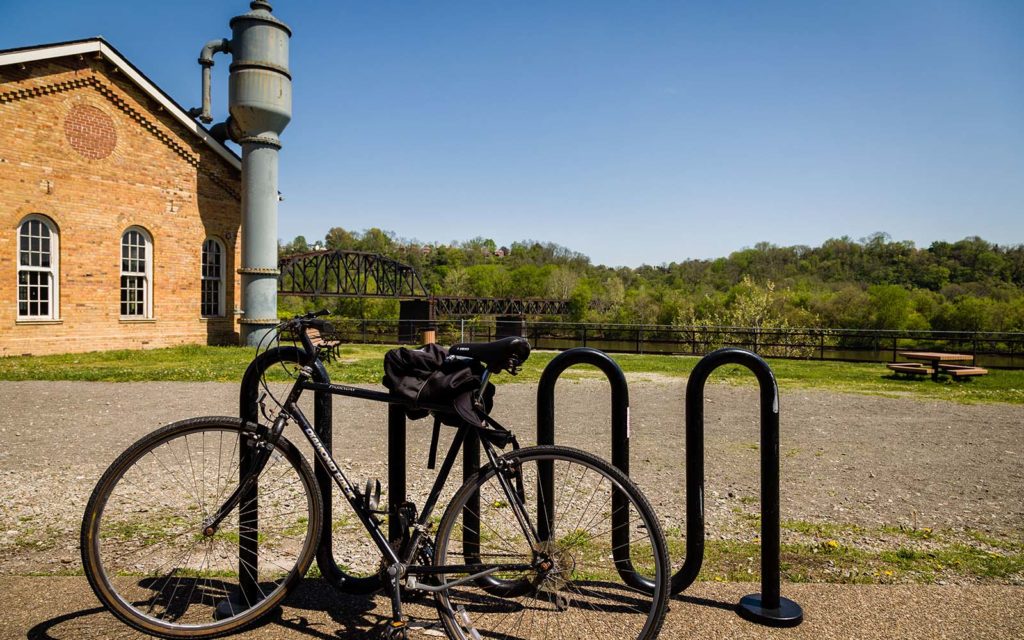
A bike parked at the historic Pump House along the trail in Munhall, PA. Photo by Richard Kelly for Rivers of Steel.
But there are lesser-known landmarks that riders have asked to know more about too.
“If you’re biking through the Kennywood area, you’ll notice a green gas line. It’s forty inches in diameter. It runs from the Clairton Coke Works, and it used to go to Homestead. It pumped a byproduct gas of the coke process, which was only maybe 60 percent as efficient as natural gas—but it was free. So Andrew Carnegie piped that in from Clairton all the way to Homestead so he could have free, sort-of natural gas to power his plants,” Bires continues.
“On our trail behind Kennywood there are cement columns about three or four feet high, and I mean there’s probably ninety of them—and people ask, ‘What is that?’ Those columns used to hold the green gas line that went to the Homestead Works. So we’d like to put up an interpretive sign about that.”
Though there is a focus on highlighting the key features of the Steel Valley, including some of the history detailed on their website, the Trail Council also wants to highlight other notable attractions as well. Bires eagerly shares that their trail boasts not one, but two osprey nests and a twenty-five-foot waterfall in Duquesne.
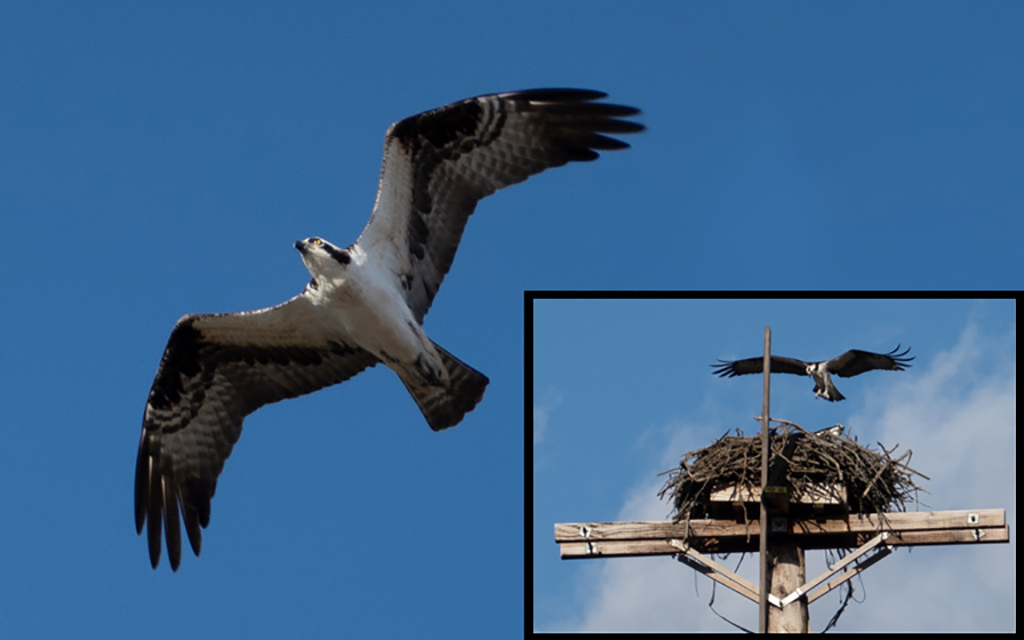
The osprey nests along the trail are just a few miles apart. The first appeared in Duquesne in 2014 and the second in McKeesport shortly thereafter, possibly built by the offspring from the birds at the first nest.
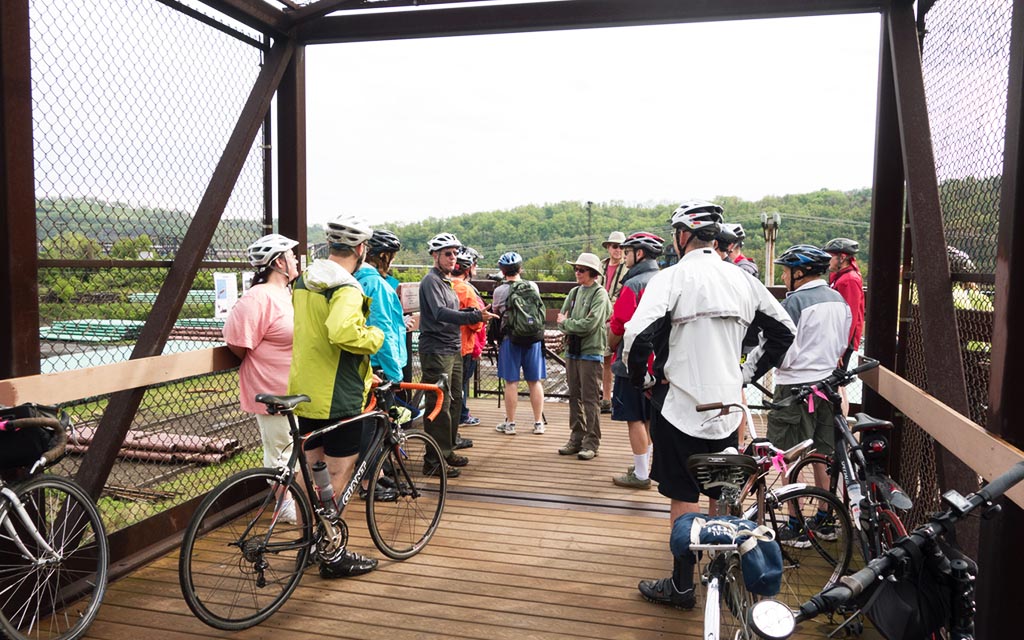
Riders stop along the trail to view the osprey nests. This map shows viewpoints along the trail for birdwatchers.
Nearly ten years after the completion of this section of the trail (and more than twenty years since the Council was incorporated), Bires is still working to raise awareness for the trail. In 2021, he was contacted by Brian Senkowicz, a Boy Scout from BSA Troop 109, about creating a series of engraved markers for the trail as his Eagle Scout project. Senkowicz has since completed carving the signs, and Bires and other Trail Council volunteers have helped to paint them. There will be seven posts installed this summer at the boundary of two municipalities, with two signs on each post with the name of the municipality that the trail crosses.

Boy Scout Brian Senkowicz and other volunteers paint signs that Brian made to identify the various communities on the trail.
“The Mon-Yough Trail Council, a neighboring RTC member, maintains a trail that is, I think, sixteen or seventeen miles long—and it only crosses through two, maybe three towns,” says Bires with a chuckle. “And our trail has all these little communities, so having the chance to create these interpretive signs and markers is a big deal.”
Learn more about Steel Valley Trail Council at steelvalleytrail.org, or check out the Great Allegheny Passage and C&O Canal Towpath TrailGuide for comprehensive mile-by-mile trail descriptions, town maps and directories, and itineraries for day trips, weekends, and thru-rides.
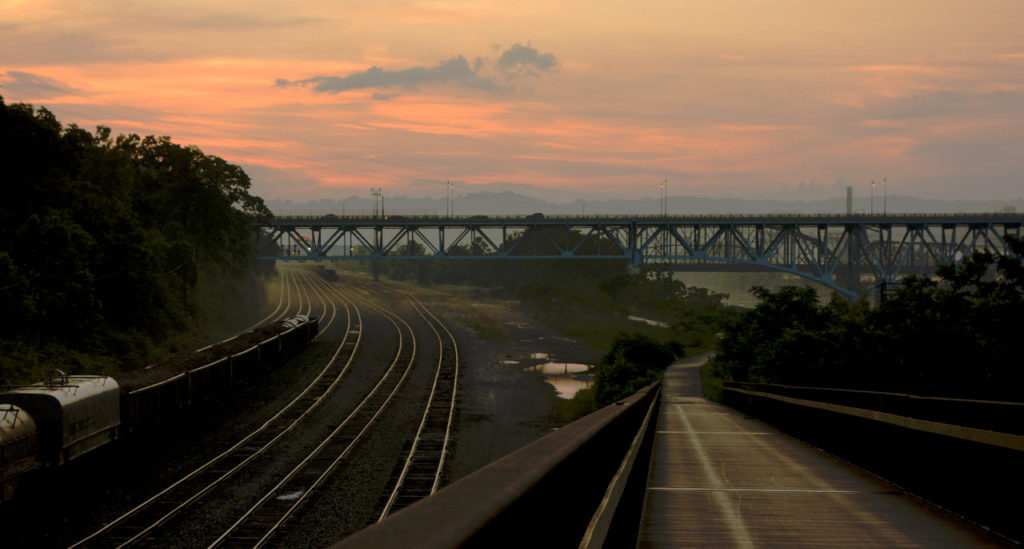
Sunset along the trail in Whitaker, 2017.
About the Mini-Grant Program
Rivers of Steel’s Mini-Grant Program assists heritage-related sites and organizations as well as municipalities within the Rivers of Steel National Heritage Area to develop new and innovative programs, partnerships, exhibits, tours, and other initiatives. Funded projects support heritage tourism, enhance preservation efforts, involve the stewardship of natural resources, encourage outdoor recreation, and include collaborative partnerships. Through these efforts, Rivers of Steel seeks to identify, conserve, promote, and interpret the industrial and cultural heritage that defines southwestern Pennsylvania.
The Rivers of Steel National Heritage Area is one of twelve supported by the Pennsylvania Department of Conservation and Natural Resources (DCNR). Funding is provided via DCNR’s Community Conservation Partnerships Program and the Environmental Stewardship Fund to Rivers of Steel, which administers the Mini-Grant Program. The Steel Valley Trail Council is one of six organizations who received Mini-Grant funding through this program in 2021.
 Gita Michulka is a Pittsburgh-based marketing and communications consultant with over 15 years of experience promoting our region’s arts, recreation, and nonprofit assets.
Gita Michulka is a Pittsburgh-based marketing and communications consultant with over 15 years of experience promoting our region’s arts, recreation, and nonprofit assets.
If you’d like to know more about community projects supported by the Mini-Grant Program, read Gita’s recent article about the restoration of the Ambridge Bicentennial House.
Photos are courtesy of the Steel Valley Trail Council, except where noted.

